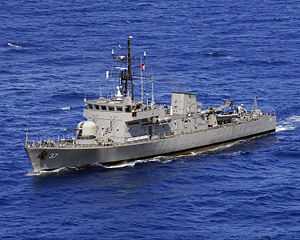Peacock-class corvette
 BRP PS37 Artemio Ricarte (ex-HMS Starling (P241) ) | |
| Class overview | |
|---|---|
| Builders: | Hall, Russell & Company. Aberdeen |
| Operators: |
|
| Preceded by: | Castle class |
| Succeeded by: | Falklands Islands Class |
| In commission: | 1 December 1982 - 1996 (Royal Navy) |
| Completed: | 5 |
| Active: |
5 (None in RN Service) Philippine Navy: HMS Peacock (P239) HMS Plover (P240) HMS Starling (P241) Irish Navy: HMS Swallow (P242) HMS Swift (P243) |
| General characteristics | |
| Displacement: | 712 tons full load |
| Length: | 62.6 m (205.4 ft) |
| Beam: | 10 m (32.8 ft) |
| Draught: | 2.72 m (8.9 ft) |
| Propulsion: | 2 diesels, 2 shafts, 14,188 bhp |
| Speed: | 25 knots |
| Complement: | 30 - 40 |
| Armament: |
|
The Peacock Class is a class of patrol corvette built for the Royal Navy. Only five were constructed, and by 1997 all had been sold to the Irish Naval Service or the Philippine Navy.
Original use
The five ships of this class were originally part of the Hong Kong Squadron of the Royal Navy. The ships were built by Hall Russell in the United Kingdom and were commissioned into Royal Navy service in 1983 and 1984. They were specifically built for service in Hong Kong with the 6th Patrol Craft Squadron; for work in tropical climates they were fully air conditioned and were capable of remaining at sea during typhoons. As well as ‘flying the flag’ and providing a constant naval presence in region, they could undertake a number of different roles including Seamanship, Navigation and Gunnery training and Search-and-Rescue duties for which they had facilities to carry divers (including a decompression chamber) and equipment to recover vessels and aircraft. They also worked with the Marine Department of the Hong Kong Police and with Customs & Excise to decrease the constant flow of illegal immigrants, narcotics and electronic equipment into the colony. For these roles each vessel could carry two Avon Searider SR5M Rigid-hulled inflatable boats and a small detachment of Royal Marines.[1]
Philippine Navy
HMS Peacock (P239), HMS Plover (P240), and HMS Starling (P241) were sold to the Philippines and were officially turned over to the Philippine Navy on 1 August 1997 after Hong Kong was returned to China. In Philippine service they are designated Jacinto class corvettes, and have been considerably 'up-gunned' with a 25mm M242 Bushmaster and two 20mm Oerlikon guns.
Irish Navy
HMS Swallow (P242) and HMS Swift (P243) were both sold to the Irish Naval Service in 1988.
The LÉ Orla (P41) was delivered in 1985 by Hall, Russell & Company[2] as HMS Swift (P243). The ship is named after Orla, a grand niece (great niece) of Brian Boru. She was murdered by her husband around 1090.[3] The crest shows the arms of Clare on the top segment and a sword and royal collar on the base.[3]
The LÉ Ciara (P42) was delivered in 1984 by Hall, Russell & Company as HMS Swallow (P242).[4] She passed to the Irish Naval Service in 1988 and was commissioned under her current name by the then Taoiseach Mr C. J. Haughey on 16 January 1989. This ship takes her name from a Tipperary saint born around the year AD611 who, after taking religious vows in her teens, founded a convent in Kilkeary, near Nenagh. The ship's coat-of-arms depict three golden chalices which represent the three ancient dioceses among which Tipperary was divided. Also featured is a Celtic cross as a representation of the North Cross at Athenny, County Tipperary. The coat of arms incorporates the Tipperary colours of Blue and Yellow as well as the background or field colours of the Tipperary Arms which is Ermine - white with a pattern of black arrowhead shaped points.
Operators
 Irish Navy
Irish Navy Philippine Navy
Philippine Navy Royal Navy (former)
Royal Navy (former)
References
External links
| ||||||||||||||||||